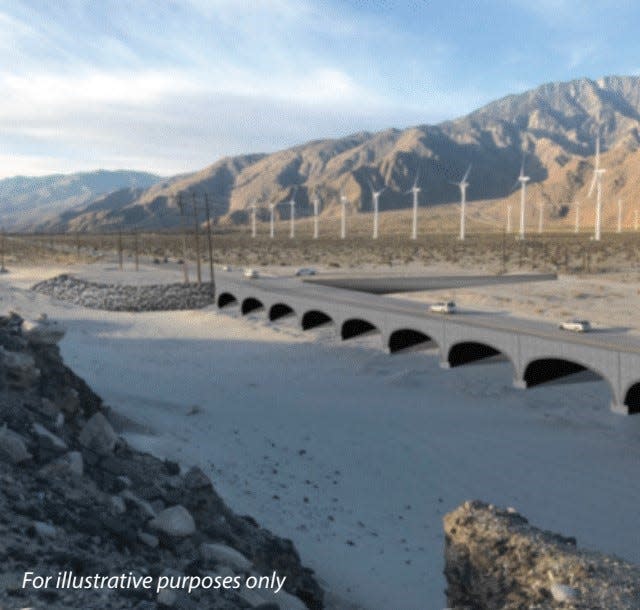State plans to award $50 million to help build bridges on Indian Canyon Drive

State officials have recommended awarding $50 million to help build bridges over Indian Canyon Drive at the Whitewater Wash, which could prove pivotal to keeping the roadway open during frequent sandstorms and flooding.
On Friday, staff at the state’s transportation commission recommended the project for $50 million in grant funding for which the Coachella Valley Association of Governments, or CVAG, applied.
The project was one of just two that received the state’s highest priority ranking. The commission will vote on whether to approve the recommendation at its Dec. 6 meeting.
The grant would provide two-thirds of the estimated $75 million cost of building the bridges. A CVAG spokesperson said the remainder of the cost would be paid for with “local and regional transportation funding.” In all, 15 projects around the state were recommended to receive grants totaling $310 million.
The commission’s climate adaption program is set to provide about $400 million in grants over five years for projects that will protect transportation infrastructure from climate change. The grants are funded through a combination of state and federal dollars, the latter coming from the $1.2 trillion infrastructure funding act passed by Congress and signed by President Joe Biden in 2021.
Flooding and blowing-sand related closures have long been an issue on Indian Canyon Drive and keep the portion of the roadway that travels through the wash closed for dozens of days each year. The problem has been particularly bad recently: CVAG has reported the road was closed for 38 days in just the first half of this year.
And the problem was underscored in August when Tropical Storm Hilary deposited several feet of sand on the roadway while doing significant structural damage to it, including washing out a section. The roadway had to be closed for about six weeks while repairs costing about half a million dollars were made.
CVAG has said the project is designed to facilitate the flow of water and sand and prevent it from building up in areas. Palm Springs City Councilmember Lisa Middleton, who has long advocated for the project, told The Desert Sun earlier this year that while the bridges will likely help with the blowing sand and reduce the need for closures, they would likely not be a cure-all.
Hilary, however, also intensified the efforts of local leaders to push the state to provide funding for the bridges.
Palm Springs Mayor Grace Garner said that when Gov. Gavin Newsom visited Palm Springs on the day of the storm’s arrival, the group of city staff and councilmembers who met with him stressed the need to fund the bridges. Representatives of the city also later visited Sacramento, where they met with members of Newsom’s staff to urge support for the bridges.
Beyond the two bridges, CVAG has said the project will also involve the creation of a two-mile walking and bike path that will be adjacent to the road and connect to the CV Link walking and bike path that travels throughout the Coachella Valley. A solar shade structure that will generate power while providing shape will be built over the pathway.
Two miles of sand fencing will also be constructed, which officials say should also help to address issues with sand buildup that has led to monthslong closures of the Amtrak station located at the north end of the corridor near the interstate. The project will also have a wildlife crossing.
The project could be a boon for the entire northwest corner of the Coachella Valley, where three of the four roadways that connect central Palm Springs to Interstate 10, Desert Hot Springs and other points north routinely close because of weather issues.
When Indian Canyon Drive, Gene Autry Trail and Vista Chino are all closed, drivers must instead take either Highway 111 or another route, such as Ramon Road to Date Palm Drive, to get the freeway. That can add as much as 20 minutes of travel time and cause traffic to back up throughout Palm Springs and Cathedral City.
And even among the three often-closed roadways, Indian Canyon Drive has outsize importance as the fastest route between much of Desert Hot Springs and Desert Regional Medical Center, the closest hospital. CVAG has also touted that the project will “provide vital access to the most underserved neighborhoods in Palm Springs, Desert Hot Springs and Cathedral City,” ensuring residents can more reliably reach both employment and their homes.
“This isn’t about travel convenience or an occasional detour,” said Desert Hot Springs Mayor Scott Matas in a statement released Wednesday. “It’s about making sure someone can get to work on time so they can put bread on the table. It can also be a matter of death for our public safety teams, who need Indian Canyon open to get to Desert Regional Medical Center.”
CVAG also previously secured $95 million to fund a bridge over the wash on Vista Chino, which provides the main northern connection between Palm Springs and Cathedral City.
paul.albani-burgio@desertsun.com
This article originally appeared on Palm Springs Desert Sun: California could pay $50 million for bridges on Indian Canyon Drive

